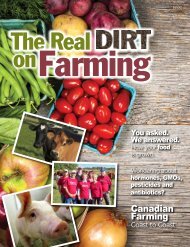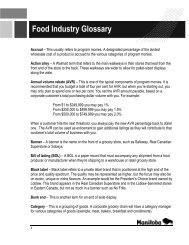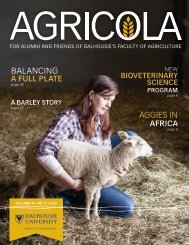SOYBEAN and BEES
BFhV4z
BFhV4z
You also want an ePaper? Increase the reach of your titles
YUMPU automatically turns print PDFs into web optimized ePapers that Google loves.
the pest abundance <strong>and</strong> the level of action recommend by IPM practices. For these cultivars,<br />
a period of ca. two weeks is extremely critical, due to the overlapping of flowers <strong>and</strong> pods, at<br />
the same time, on soybean plants.<br />
Honeybee visitation to a flower can be considered a two-stage process. At first involves orientation<br />
from a larger distance <strong>and</strong> then, secondarily, close-range orientation during which<br />
the bee alights <strong>and</strong> probes for nectar. Bees are guided to particular flowers by floral aroma,<br />
color, <strong>and</strong> shape. Floral aroma, color, <strong>and</strong> shape all therefore appear to influence initial honeybee<br />
visitation <strong>and</strong> provide foraging l<strong>and</strong>marks, which honeybees utilize to optimize foraging<br />
on a specific plant species.<br />
Nectar is a powerful attractant of bees to a given flower. Nectar is a complex of carbohydrates,<br />
basically a solution of fructose, glucose, or sucrose in water with minute amounts of<br />
many other plant compounds like other carbohydrates, amino acids, proteins, mineral ions,<br />
organic acids, vitamins, lipids, antioxidants, glycosides, alkaloids, <strong>and</strong> flavonoids. Content of<br />
carbohydrate in the nectar may vary, from 4 to 60%, depending on species <strong>and</strong> on environmental<br />
conditions, <strong>and</strong> there is also a variation according to the time of the day, what may<br />
determine foraging hours.<br />
The importance of olfaction in recruitment of forager honeybees has been well documented.<br />
Honeybees have large numbers of antennal placoid sensilla, which are the principal chemoreceptors<br />
for floral aromas. Indeed, it has been suggested that olfaction plays a more important<br />
role in forager recruitment than the dance maneuvers observed in colonies. Scent<br />
is more important in conditioning honeybees than color, form, or time of day, as honeybee<br />
discrimination was greater with a change of scent than with a change of flower pattern or<br />
shape.<br />
At first, it is not fairly acceptable that increasing soybean yields would depend on<br />
cross-pollination, considering that on cleistogamic plants, when the flower opens it is<br />
normally fertilized. Natural cross-pollination in soybeans has been estimated to be low,<br />
ranging from about 0.03% to 3.62%. This low cross-pollination would indicate that the<br />
entomophilous pollination would represent very low impact on soybean yield. However,<br />
there is a controversy on the contribution of pollinators for increasing the yield <strong>and</strong> seed<br />
quality on soybeans. Some authors have found that the presence of pollinators, especially<br />
honeybees, in open field environment, or on caged soybeans, lead to the increment of<br />
soybean yield. This is still an open issue, because it is not the expected behavior of a<br />
cleistogamic, self-pollinating plant, with an average of only 2% cross-pollination. When<br />
larger soybeans yields were found, no physiological evidences were stated to support<br />
the findings.






